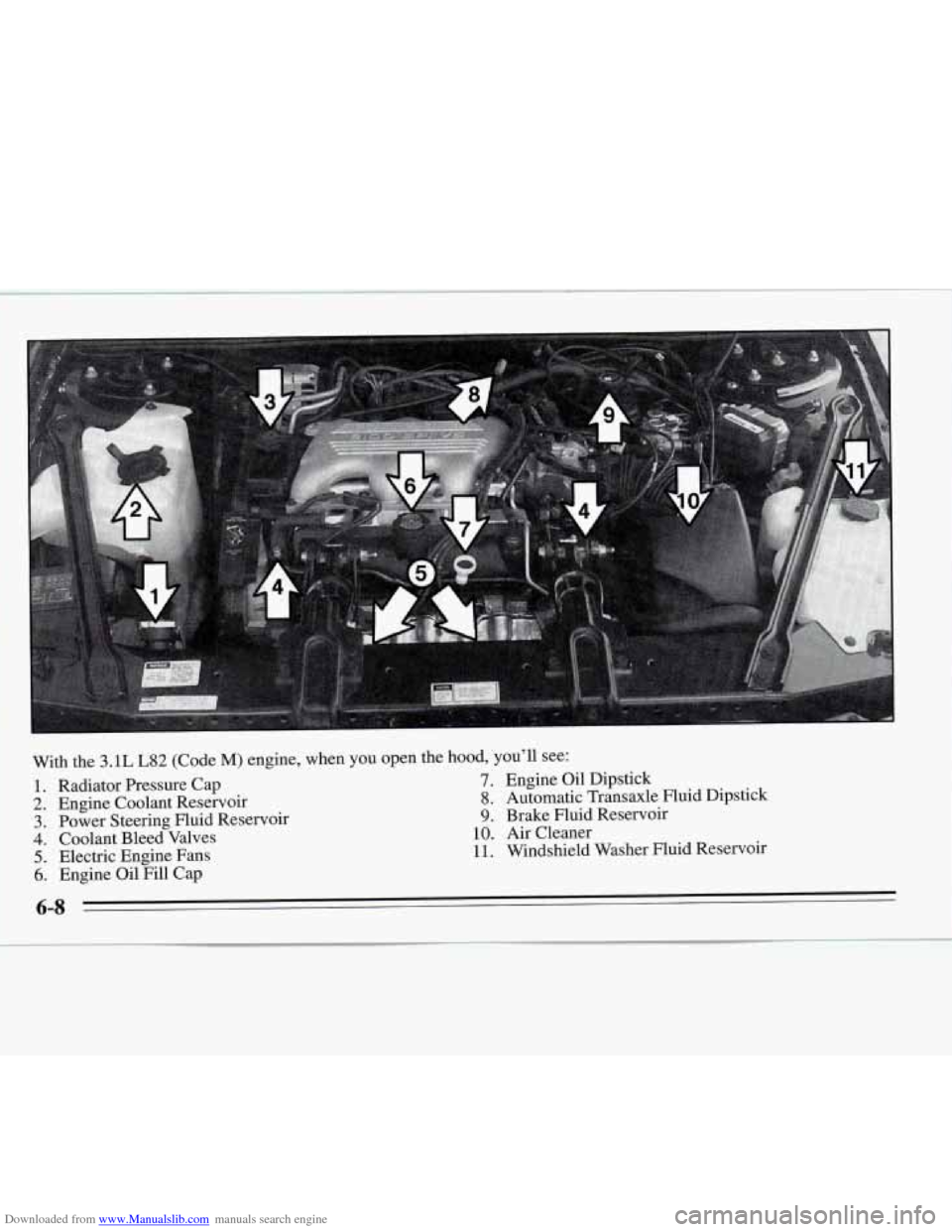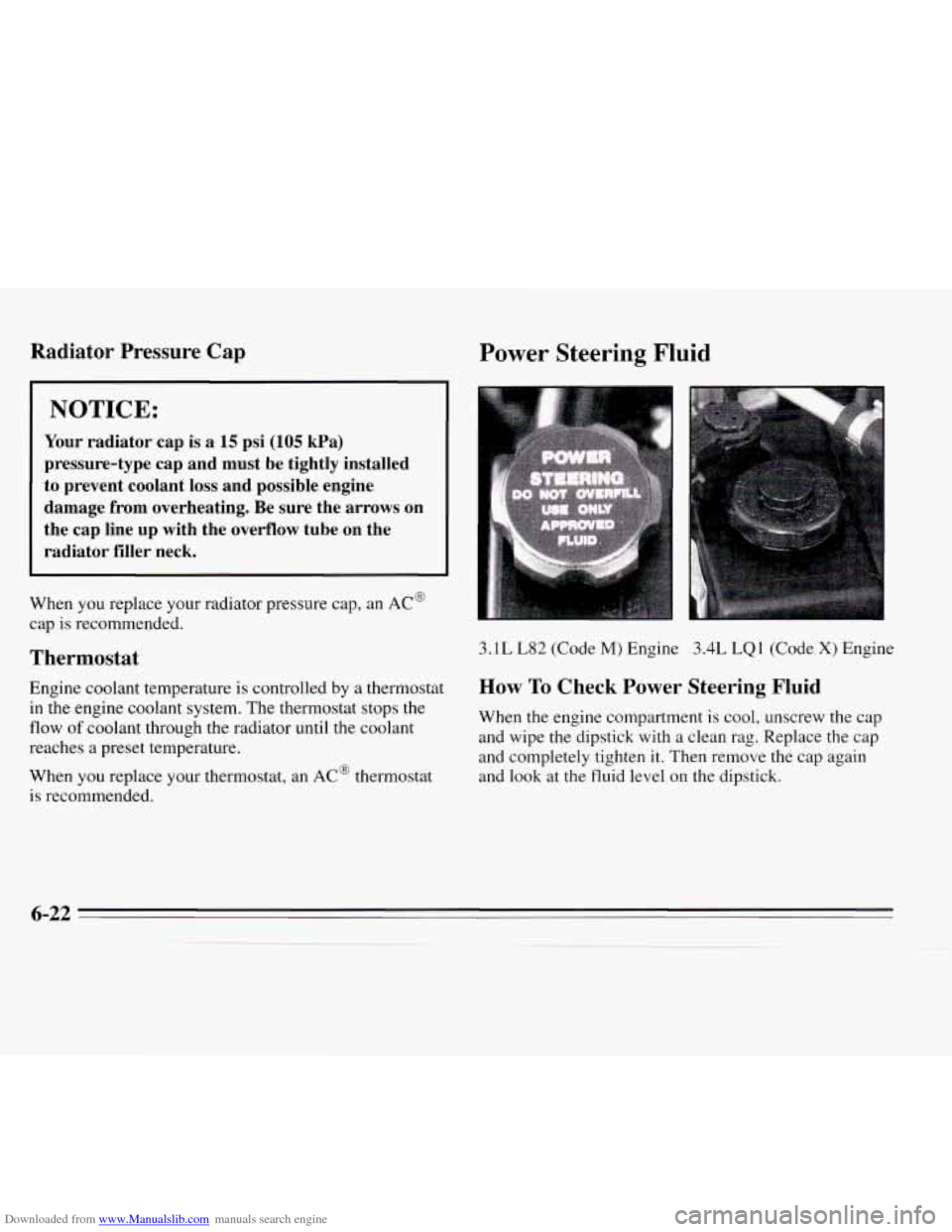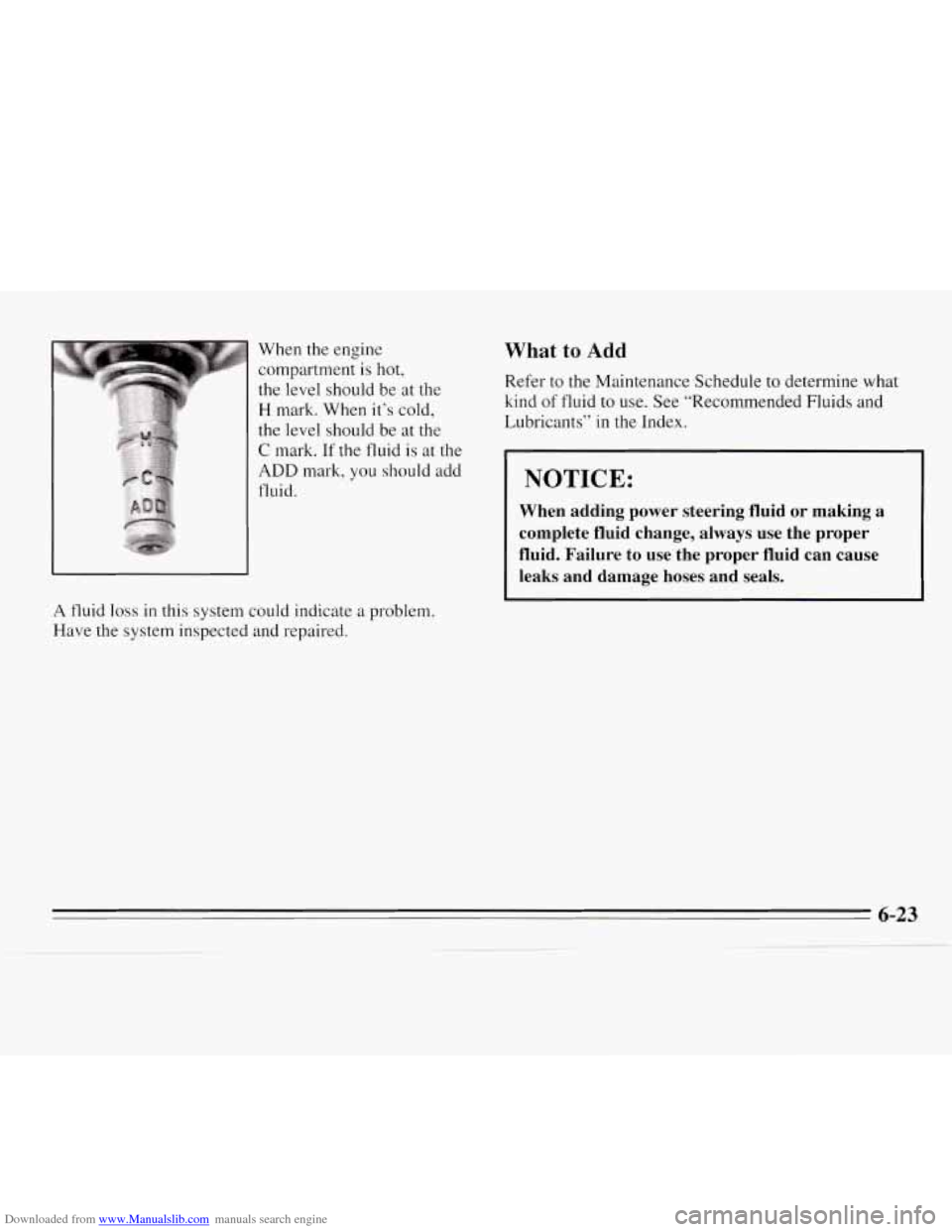power steering CHEVROLET MONTE CARLO 1995 5.G Owners Manual
[x] Cancel search | Manufacturer: CHEVROLET, Model Year: 1995, Model line: MONTE CARLO, Model: CHEVROLET MONTE CARLO 1995 5.GPages: 324, PDF Size: 16.74 MB
Page 80 of 324

Downloaded from www.Manualslib.com manuals search engine Power Windows (Option)
Switches on the driver's door armrest control each of the
windows when the ignition is on. In addition, the
passenger door has a switch for its own window.
The driver's window switch has an Auto Down feature.
This switch is labeled
AUTO. Tap the rear of the switch,
and the driver's window will open a small amount.
If
the rear of the switch is pressed all the way down, the
window will go all the way down.
To stop the window while it is lowering, press the front
of the switch. To raise the window, press and hold the
front of the switch.
Horn
Press either horn symbol on your steering wheel to
sound the horn.
Tilt Steering Wheel
A tilt steering wheel allows
you to adjust the steering
wheel before you drive.
You
can also raise it to the
highest level to give your
legs more room when you
exit and enter the vehicle.
To tilt the wheel, hold the steering wheel and pull the
lever. Move the steering wheel to
a comfortable level,
then release the lever to lock the wheel in place.
2-24
Page 136 of 324

Downloaded from www.Manualslib.com manuals search engine Remember: Anti-lock doesn’t change the time you need
to get your foot up to the brake pedal. If you get too
close to the vehicle in front of you, you won’t have time
to apply your brakes if that vehicle suddenly slows or
stops. Always leave enough room up ahead
to stop, even
though
you have anti-lock brakes.
To Use Anti-Lock
Don’t pump the brakes. Just hold the brake pedal down
and let anti-lock work for you.
You may feel the system
worhng, or you may notice some noise, but this is
normal. When your anti-lock system
is adjusting brake
pressure to help avoid a braking skid, the
LOW TRAC
light will come on. See “Anti-Lock Brake System
Active Light” in the Index.
Braking in Emergencies
Use your anti-lock braking system when you need to.
With anti-lock, you can steer and brake at the same
time.
In many emergencies, steering can help you more
than even the
very best braking.
Steering
Power Steering
If you lose power steering assist because the engine
stops or the system is not functioning, you can steer but
it will take much more effort.
Steering Tips
Driving on Curves
It’s important to take curves at a reasonable speed.
A
lot of the “driver lost control” accidents mentioned on
the news happen on curves. Here’s why:
Experienced driver
or beginner, each of us is subject to
the same laws of physics when driving on curves. The
traction of the tires against the road surface makes
it
possible for the vehicle to change its path when you turn
the front wheels. If there’s no traction, inertia will keep
the vehicle going in the same direction. If you’ve ever
tried to steer
a vehicle on wet ice, you’ll understand this.
Page 202 of 324

Downloaded from www.Manualslib.com manuals search engine 1 LA
1. Radiator Pressure Cap
2. Engine Coolant Reservoir
3. Power Steering Fluid Reservoir
4. Coolant Bleed Valves
5. Electric Engine Fans
7. Engine Oil Dipstick
8. Automatic Transaxle Fluid Dipstick
9. Brake Fluid Reservoir
10. Air Cleaner
11. Windshield Washer Fluid Reservoir
6. Engine OilFill Cap
6-8
Page 203 of 324

Downloaded from www.Manualslib.com manuals search engine 1.
2.
3.
4.
5.
6.
With the 3.4L LQ1 (Code X) engine, when you open the hood, you’ll see:
Radiator Pressure Cap Engine Coolant Reservoir
Power Steering Fluid Reservoir
Electric Engine Fans
Engine Oil Dipstick
Engine Oil
Fill Cap
7. Coolant Bleed Valves
8. Automatic Transaxle Fluid Dipstick
9. Brake Fluid Reservoir
10. Air Cleaner
11. Windshield Washer Fluid Reservoir
6-9
Page 216 of 324

Downloaded from www.Manualslib.com manuals search engine Radiator Pressure Cap
NOTICE:
Your radiator cap is a 15 psi (105 kPa)
pressure-type cap and must be tightly installed
to prevent coolant loss and possible engine
damage from overheating. Be sure the arrows on
the cap line up with the overflow tube on the
radiator filler neck.
When you replace your radiator pressure cap, an AC@
cap is recommended.
Thermostat
Engine coolant temperature is controlled by a thermostat
in the engine coolant system.
The thermostat stops the
flow of coolant through the radiator until the coolant
reaches a preset temperature.
When you replace your thermostat, an
AC@ thermostat
is recommended.
Power Steering Fluid
3.1 L L82 (Code M) Engine 3.4L LQ 1 (Code X) Engine
How To Check Power Steering Fluid
When the engine compartment is cool, unscrew the cap
and wipe the dipstick with a clean rag. Replace the cap
and completely tighten
it. Then remove the cap again
and look at the fluid level on the dipstick.
6-22
Page 217 of 324

Downloaded from www.Manualslib.com manuals search engine When the engine
compartment
is hot,
the level should be at the
H mark. When it’s cold,
the level should be at the
C mark. If the fluid is at the
ADD mark, you should add
fluid.
What to Add
Refer to the Maintenance Schedule to determine what
kind of fluid to use. See “Recommended Fluids and
Lubricants” in the Index.
A fluid loss in this system could indicate a problem.
Have the system inspected and repaired.
I NOTICE:
When adding power steering fluid or making a
complete fluid change, always use the proper
fluid. Failure
to use the proper fluid can cause
leaks and damage hoses and seals.
6-23
Page 297 of 324

Downloaded from www.Manualslib.com manuals search engine Part C: Periodic Maintenance
Inspections
Listed below are inspections and services which should
be performed at least twice a year (for instance, each
spring and fall). You should let your
GM dealer’s service
department or other qualified service center do these jobs.
Make sure
any necessary repairs are completed at once.
Restraint Systems
Now and then, make sure all your belts, buckles, latch
plates, retractors, anchorages and reminder systems are
working properly. Look for any loose parts or damage.
If you see anything that might keep a restraint system
from doing its job, have it repaired.
Steering, Suspension and
Front-Wheel-Drive Axle Boot
and
Seal Inspection
Inspect the front and rear suspension and steering
system for damaged, loose or missing parts, signs of
wear, or lack of lubrication. Inspect the power steering
lines and hoses for proper hookup, binding, leaks,
cracks, chafing, etc. Clean and then inspect the drive
axle boot seals for damage, tears or leakage. Replace
seals
if necessary.
Exhaust System Inspection
Inspect the complete exhaust system. Inspect the body
near the exhaust system. Look for broken, damaged,
missing or out-of-position parts as well as open
seams,
holes, loose connections, or other conditions which
could cause a heat build-up
in the floor pan or could let
exhaust fumes into the vehicle. See “Engine Exhaust”
in
the Index.
Throttle Linkage Inspection
Inspect the throttle linkage for interference or binding,
and for damaged or missing parts. Replace parts as
needed.
Brake System Inspection
Inspect the complete system. Inspect brake lines and
hoses for proper hookup, binding, leaks, cracks, chafing,
etc. Inspect disc brake pads
for wear and rotors for
surface condition.
Also inspect drum brake linings for
wear and cracks. Inspect other brake parts, including
drums, wheel cylinders, calipers, parking brake, etc.
Check parking brake adjustment.
You may need to have
your brakes inspected more often if your driving habits
or conditions result in frequent braking.
7-39
Page 298 of 324

Downloaded from www.Manualslib.com manuals search engine Part D: Recommended Fluids and
Lubricants
NOTE: Fluids and lubricants identified below by name,
part number or specification may be obtained from your
GM dealer.
USAGE
Engine Oil
Engine Coolant
FLUIDfiUBRICANT
Engine oil with the American
Petroleum Institute Certified For Gasoline Engines “Starburst”
symbol
of the proper viscosity. To
determine the preferred viscosity
for your vehicle’s engine, see
“Engine Oil” in the Index.
50/50 mixture of water (preferably
distilled) and good quality
ethylene glycol base antifreeze
(GM Part No. 1052753 or
equivalent) conforming to GM
Specification 1825M or approved
recycled coolant conforming to
GM Specification 1825M.
USAGE FLUIDfiUBRICANT
Coolant GM Part No. 3634621 or
Supplement equivalent with a complete flush
Hydraulic Brake Delco Supreme
ll@ Brake Fluid
System (GM Part
No. 1052535 or
equivalent DOT-3 brake fluid).
Parking Brake Chassis lubricant (GM Part
Guides
No. 1052497 or equivalent) or
and refill.
lubricant meeting requirements of
NLGI Grade 2, Category LB or
GC-LB.
Power Steering GM Hydraulic Power Steering
System Fluid (GM Part
No. 1052884 or
equivalent).
Automatic DEXRON@-I11 Automatic
Transaxle Transmission Fluid.
Key Lock Lubricate with Multi-Purpose
Cylinders Lubricant (GM Part
No. 12345 120) or synthetic
SAE 5W-30 engine oil.
7-40
Page 311 of 324

Downloaded from www.Manualslib.com manuals search engine 0 Section 9 Index
ABS ......................................... 4-6
Adding Automatic Transaxle Fluid
..................... 6- I9
Brake Fluid
................................. 6-26
Electrical Equipment
............... 2- 12 . 3- IS. 6-53
Engine Coolant
.............................. 6-20
Engine Oil
.................................. 6- 12
Power Steering Fluid ......................... 6-23
Sound Equipment
............................ 3- 15
Windshield Washer Fluid ...................... 6-24
AirBag
....................................... 1-17
How Does It Restrain ......................... 1-2 1
How It Works ............................... 1 - 19
Location ................................... 1-19
Readiness Light ........................ I - 18. 2-44
Servlclng 1-22
What Makes
It Inflate ......................... 1-20
What Will You See After It Inflates .............. 1-21
When Should It Inflate ........................ 1-20
Aircleaner
.................................... 6-15
Air Conditioning ................................ 3-3
Air Conditioning Refrigerants ..................... 6-62
Air Conditioning with Electronic Controls ............ 3- 1
Alignment and Balance, Tires ..................... 6-41
Aluminum Wheels
. Cleaning ...................... 6-49
Antenna
. Fixed Mast ............................ 3- 17
.. ...................................
Antifreeze ..................................... 6-19
Anti-Lock Brake System Warning Light
......... 2.46. 4.6
Anti-Lock Brakes
............................... 4-6
Anti-Theft Feature. Theftlock
..................... 3-13
Appearancecare
............................... 6-44
Appearance Care and Materials
.................... 6-52
Armrest. Storage
............................... 2-36
Ashtrays. Front
................................. 2-38
Ashtrays. Rear
................................. 2-39
Audio Systems
.................................. 3-5
Auto-Down Window
............................ 2-24
Automatic Transaxle
............................ 2-14
Drive (D) Position
............................ 2-16
First Gear (1) Position
........................ 2-17
Neutral (N) Position
.......................... 2-15
Overdrive (@I) Position ........................ 2-16
Park Mechanism and Parking Brake Check
........ 7-38
Park
(P) Position ............................. 2-14
Reverse (R) Position
.......................... 2-15
Second Gear (2) Position
...................... 2-17
Shifting
.................................... 2-14
Automatic Transaxle Fluid
........................ 6-16
Adding
.................................... 6-19
Checking
................................... 6-16
Anti-Lock Brake System Active Light
.............. 2-47
Audio Systems. Steering Wheel Touch Controls
....... 3-17
9-1
Page 312 of 324

Downloaded from www.Manualslib.com manuals search engine Back-up Lamp Bulb Replacement ................ 6-35
Charge Light
................................ 2-43
.. .Jump Starting 5-2 . Replacement, Remote Lock Control ............... 2-6
Saver
...................................... 2-33
Warnings .................................... 5-2
Bleed Valves, Coolant
........................... 5-19
Fluid, Adding
............................... 6-26
Master Cylinder
............................. 6-25
System Parts, Replacing
....................... 6-27
System Warning Light
........................ 2-45
Transaxle Shift Interlock
....................... 2-21
Transaxle Shift Interlock, Maintenance
........... 7-37
Brakes, Anti-Lock
............................... 4-6
Braking
........................................ 4-5
Braking, In Emergencies .......................... 4-8
Break-In, New Vehicle
.......................... 2-10
BTSI (Brake Transaxle Shift Interlock)
.............. 2-21
Bulb Replacement
......................... 6-28, 6-60
Battery
....................................... 6-27
................................
................................. BBB Auto Line
8-3
Blizzard
...................................... 4-24
Brake Adjustment
................................. 6-27
Parking
.................................... 2-18
Pedal Travel ................................ 6-27
Trailer
..................................... 4-31
Wear
...................................... 6-26
BTSI (Brake Transaxle Shift Interlock), Maintenance
. . 7-37
Canada. Vehicles First Sold In u .. .......................
Canadian Roadside Assistance ...................... 8-7
Capacities aqd Specifications ...................... 6-61
Carbon Monoxide
.................... 2-22.4-25.. 4-31
Cassette Deck. Maintenance
...................... 7-36
Cassette Tape Player
........................ 3-7. 3-10
Cassette Tape Player Care
........................ 3-16
CDPlayer ..................................... 3-12
Center High-Mounted Stoplamp Bulb Replacement
.... 6-33
Center Passenger Position
........................ 1-23
Certification Label
.............................. 4-26
Chains. Safety
................................. 4-31
Changing a Flat Tire
............................. 5-22
Charging System Light
.......................... 2-43
Checking
Your Restraint Systems .................. 1-46
Automatic Transaxle
Fluid ..................... 6-16
Engine Coolant
.............................. 6-20
Power Steering Fluid
......................... 6-22
Restraint Systems
............................ 1-46
Things Under the
Hood ........................ 6-7
Chemical Paint Spotting
.......................... 6-51
Securing in
a Rear Outside Seat Position .......... 1-35
Securing
in the Center Rear Seat Position ......... 1-37
Securing in the Right Front Seat Position
.......... 1-39
................................. Center Console 2-37
................................... Chains. Tire 6-43
Checking BrakeFluid
................................. 6-25
Engine Oil 6-11
..................................
ChildRestraints ........,...........,........... l-33